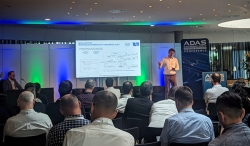Neue Produkte Auf Der Messe
DAY 2: BMW, Audi, Volvo, ZF and Stellantis share their insights into safety and virtual validation, scenarios, ODDs and more
ADAS & Autonomous Vehicle Technology Conference
 On Day 2 of the conference at ADAS & Autonomous Vehicle Technology Expo Europe, discussions in Room 1 have focused on demonstrating safety and validating and homologating automated driving systems for the deployment of Level 2+ technologies and beyond, with Applus Idiada, SIA and AVL contributing their insights.
On Day 2 of the conference at ADAS & Autonomous Vehicle Technology Expo Europe, discussions in Room 1 have focused on demonstrating safety and validating and homologating automated driving systems for the deployment of Level 2+ technologies and beyond, with Applus Idiada, SIA and AVL contributing their insights.
In the ‘Learning from real-world and proving ground test and deployment, and integrated virtual testing’ session, Dr Sebastian Siegl, function verification and validation strategy manager for automated driving functions at Audi, will speak on evolving proving grounds for the development and validation of AD in different ODDs.
Dr Roman Krzemien, head of safety and cybersecurity, mobility at ZF, and Andreas Wohlfarth, head of safety (SOTIF) and cybersecurity, mobility at ZF, will present a mobility safety case study focused on operational safety.
In the morning session, Renault's general manager for synthesis and immersive simulation, Didier Wautier, delved into the journey from digital vehicle to virtual twin to immersive virtual twin.
In Room 2, presentations have explored state-of-the-art scenario-based testing and simulation, beginning with Foretellix's chief regulatory affairs officer, Gil Amid, whose presentation was titled ‘Safety-driven validation: when ODD meets OpenSCENARIO 2.0’.
BMW Group's systems architect for virtual test and validation, Carlo van Driesten, spoke on ‘Enabling virtual test and validation – self-sovereign identity via OIDC to enable decentralized open data markets’. In an interview with ADAS & Autonomous Vehicle International following his presentation, Carlo said, “You do the standardization to have a common language, then we can describe something like a digital map and build a process to define the quality, with a credible modeling process. Currently we judge the quality by pricing it in the same way you would price a pencil: via its classifications or product description. The intention is to describe simulation assets to make them comparable, then we can use an innovation like an NFT to create a digital twin or representation of it to trade the policy, which means, for example, the right to download. For this policy trade, it's described by a triple: 1) the digital identity; 2) the representation of the asset; 3) the policy. The moment you can describe all those things and execute it, you can create digital markets for digital data.
“This all relies on different pillars, namely: open source to be able to publish, make it usable and visible; standardization, to interface with others in a compliant legal framework, such as ASAM; acknowledging that we're in a competitive space so cooperating 'coopetition'; and finally, looking to other innovations in other domains, such as the digital art scene, and adapting them for our use case and checking against our requirements.”
Speaking of the show, van Driesten said, “I come to ADAS & Autonomous Vehicle Technology Expo Europe because I can meet with other experts across the ADAS ecosystem.”
Also at the conference, presenters from Volvo are discussing several case studies. In a presentation titled ‘How to battle the billion-mile problem using scenarios’, Mattias Eriksson, product owner - software-in-the-loop, explained how to measure launch readiness more quickly to increase the rate of ODD expansion and functional growth. Carina Björnsson, the company’s technical expert for driver assistance and active safety test methods, described method development of test track testing of a head-on scenario.
A highlight of Day 2 will be a panel discussion at 4.10pm, which will explore using and integrating scenarios and ODDs to best achieve state-of-the-art safety. Moderated by Marc Pajon, a consultant at Taktech, the panel will include Vincent Abadie, senior fellow ADAS and autonomous driving at Stellantis; Dr Andreas Richter, engineering program manager - operational design domains at Volkswagen Commercial Vehicles; Carlo van Driesten, systems architect for virtual test and validation at BMW Group; and Hakim Mohellebi, an expert in engineering simulation functional architecture at Renault.
The conference will continue on Day 3 with sessions on developments in connectivity, mapping and positioning; advanced simulation and in-the-loop testing; best practices for the development, acceleration and safe deployment of ADAS and AV technologies; and development, test, deployment and evaluation of sensors.

